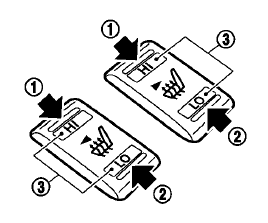Heated seats (if so equipped)
WARNING
Do not use or allow occupants to use the seat heater if you or the occupants cannot monitor elevated seat temperatures or have an inability to feel pain in body parts that contact the seat. Use of the seat heater by such people could result in serious injury.
CAUTION
• The
battery could run down if the
seat heater is operated while the
engine is not running.
• Do not use the
seat heater for
extended periods or when no one
is using the seat.
• Do not put
anything on the seat
which insulates heat, such as a
blanket, cushion, seat cover, etc.
Otherwise, the seat may become
overheated.
• Do not place
anything hard or heavy
on the seat or pierce it with a pin or
similar object. This may result in
damage to the heater.
• Any liquid
spilled on the heated seat
should be removed immediately
with a dry cloth.
• When cleaning
the seat, never use
gasoline, thinner, or any similar
materials.
• If any
malfunctions are found or the
heated seat does not operate, turn
the switch off and have the system
checked by a NISSAN dealer.

The seats are warmed by built-in heaters. The switches located on the center console and rear doors (if so equipped for rear seats) can be operated independently of each other.
1. Start the engine.
2. Select heat range.
1 For high heat, push the HI (High) side of
the switch.
2 For low heat, push the LO (Low) side of
the switch.
The indicator light in the switch 3 will illuminate when the heater is on.
3. To turn off the heater, return the switch to the level position. Make sure the indicator light goes off.
The heater is controlled by a thermostat, automatically turning the heater on and off.
The indicator light will remain on as long as the switch is on.
When the vehicle’s interior is warmed, or before you leave the vehicle, be sure to turn off the switch.
See also:
Vehicle load capacity
Do not exceed the load limit of your vehicle
shown as “The combined weight of
occupants and cargo” on the Tire and
Loading Information label. Do not exceed
the number of occupants shown as
†...
Vents
Adjust air flow direction for the driver’s and passenger’s
side vents 1 , center vents 2 , and rear
vents 3 by moving the vent slide and/or vent
assemblies.
Open or close the vents using t ...
Vehicle loading information
- It is extremely dangerous to ride in a cargo area inside the vehicle.
In a collision, people riding in these areas are more likely to be seriously
injured or killed.
- Do not allow people to r ...
